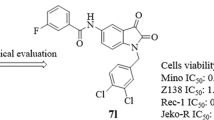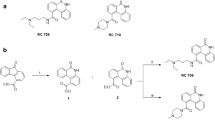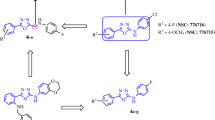Summary
Twelve multi-functional pyrrolizidinones, indolizidinones and pyrroliazepinones were prepared from formal aza-[3 + 2] and aza-[3 + 3] cycloadditions of five- to seven-membered heterocyclic enaminones as diverse ambident electrophiles. The antitumor activity of these alkaloid-like compounds was investigated through an initial screening performed on human glioblastoma multiform (GBM) cell lines (GL-15, U251), on murine glioma cells line (C6) and on normal glial cells. Of the compounds tested, the new pyrrolo[1,2a]azepinone, [ethyl (3-oxo-1,2-diphenyl-6,7,8,9-tetrahydro-3H-pyrrolo[1,2a]azepin-9a(5H)-yl)acetate] or (Compound-13) exhibited selective cytotoxic effects on GBM-temozolomide resistant cells. Compound-13 exerted dose-dependent cytotoxic activity by promoting arrest of cells in the G0/G1 phase of the cell cycle in the first 24 h. The apoptotic effect observed was in a time-dependent manner. Anti-migratory effect promoted by the treatment with compound-13 was also observed. Moreover, healthy mixed glial cell cultures from rat brain exhibited no cytotoxicity effect upon exposure to compound-13. Thus, the present study paves the way for the use of compound-13 as novel antitumor scaffold candidate for glioma cell therapy.






Similar content being viewed by others
References
Ostrom QT et al (2015) CBTRUS statistical report: primary brain and central nervous system tumors diagnosed in the United States in 2008-2012. Neuro-Oncology 17:1–62
Tran B, Rosenthal MA (2010) Survival comparison between glioblastoma multiforme and other incurable cancers. J Clin Neurosci 17:417–421
Khosla D (2016) Concurrent therapy to enhance radiotherapeutic outcomes in glioblastoma. Ann Transl Med 4:3–54
Villà S, Balaňà C, Comas S (2014) Radiation and concomitant chemotherapy for patients with glioblastoma multiforme. Chin J Cancer 33:25–31
Hegi ME et al (2008) Correlation of O 6 -Methylguanine Methyltransferase ( MGMT ) promoter methylation with clinical outcomes in Glioblastoma and clinical strategies to modulate MGMT activity. J Clin Oncol Soc 26:4189–4199
Banelli B et al (2015) The histone demethylase KDM5A is a key factor for the resistance to temozolomide in glioblastoma. Cell Cycle 14:3418–3429
Zheng M, Wang S, Liu Z, Xie L, Deng Y (2018) Development of temozolomide coated nano zinc oxide for reversing the resistance of malignant glioma stem cells. Mater Sci Eng C 83:44–50
Shi J, Dong B, Zhou P, Guan W, Peng Y (2017) Functional network analysis of gene-phenotype connectivity associated with temozolomide. Oncotarget 8:87554–87567
Verhaak RGW et al (2010) Integrated genomic analysis identifies clinically relevant subtypes of Glioblastoma characterized by abnormalities in PDGFRA, IDH1, EGFR, and NF1. Cancer Cell 17:98–110
Karkhanis M and Park J.I., (2010). Sp1 regulates Raf/MEK/ERK-induced p21CIP1 transcription in TP53-mutated cancer cells, Cell Signal, 64:645–662
Costa SL, Paillaud E, Fages C, Rochette-egly C, Plassat JL (2001) Effects of a novel synthetic retinoid on malignant glioma in vitro : inhibition of cell proliferation , induction of apoptosis and diferentiation. Eur J Cancer 37:520–530
Huszthy PC et al (2012) In vivo models of primary brain tumors: pitfalls and perspectives. Neuro-Oncology 14:979–993
Barth RF, Kaur B (2009) Rat brain tumor models in experimental neuro-oncology: the C6, 9L, T9, RG2, F98, BT4C, RT-2 and CNS-1 gliomas. J Neuro-Oncol 94:299–312
Eisele G, Weller M (2013) Targeting apoptosis pathways in glioblastoma. Cancer Lett 332:335–345
Barajas RF et al (2012) Regional variation in histopathologic features of tumor specimens from treatment-naive glioblastoma correlates with anatomic and physiologic MR imaging. Neuro-Oncology 14:942–954
Elkamhawy A et al (2015) Discovery of potent and selective cytotoxic activity of new quinazoline-ureas against TMZ-resistant glioblastoma multiforme (GBM). Eur J Med Chem 103:210–222
Cholewiñski G, Dzierzbicka K, Koodziejczyk AM (2011) Natural and synthetic acridines / acridones as antitumor agents : their biological activities and methods of synthesis, Pharmacol. Reports 1:7–12
Fattorusso SOTE (2008) Modern alkaloids: Strucure, isolation, synthesis, and biology. Wilye, New York, VHC 29–33
Robertson J, Stevens K (2014) Pyrrolizidine alkaloids. Nat Prod Rep 31:1721–1788
Michael JP (2016) Simple indolizidine and quinolizidine alkaloids, alkaloids. Chem Biol 75:1–498
Pilli RA, Rosso GB, de Oliveira Mda C (2010) The chemistry of Stemona alkaloids: an update. Nat Prod Rep 27:1908
Alibes R, Figueredo M (2009) Strategies for the synthesis of Stemona alkaloids, European J. Org Chem 15:2421–2435
Chattopadhyay AK, Hanessian S (2015) Cyclic enaminones. Part I: stereocontrolled synthesis using diastereoselective and catalytic asymmetric methods. Chem Commun 51:16437–16449
Hussaini SR, Chamala RR, Wang Z (2015) The Eschenmoser sulfide contraction method and its application in the synthesis of natural products. Tetrahedron 71:6017–6086
Seki H, Georg GI (2014) 2,3-dihydropyridin-4(1 H)-ones and 3-aminocyclohex-2-enones: synthesis, functionalization, and applications to alkaloid synthesis. Synlett 25:2536–2557
Ferraz HMC, Gonçalo ERS (2007) Recent preparations and synthetic applications of enaminones. Quim Nova 30:957–964
Cheng Y, Huang ZT, Wang MX (2004) Heterocyclic enamines: the versatile intermediates in the synthesis of heterocyclic compounds and natural products. Curr Org Chem 8:325–351
Negri G, Kascheres C, Kascheres AJ (2004) Recent development in preparation reactivity and biological activity of enaminoketones and enaminothiones and their utilization to prepare heterocyclic compounds. J Heterocyclic Chem 41:461–491
Kascheres CM (2003) The chemistry of enaminones, diazocarbonyls and small rings: our contribution. J Braz Chem Soc 14:945–969
Elassar AZA, El-Khair AA (2003) Recent developments in the chemistry of enaminones. Tetrahedron 59:8463–8480
Ferraz HMC, Pereira FLC (2004) Síntese de enaminonas. Quim Nova 27:89–95
Chattopadhyay AK, Hanessian S (2015) Cyclic enaminones. Part II: applications as versatile intermediates in alkaloid synthesis. Chem Commun (Camb) 51:16450–16467
Pitanga BP, Nascimento RP, Silva VD, Costa SL (2012) The role of astrocytes in metabolism and neurotoxicity of the pyrrolizidine alkaloid monocrotaline, the main toxin of Crotalaria retusa. Front Pharmacol 3:1–7
Barreto RA et al (2008) Monocrotaline pyrrol is cytotoxic and alters the patterns of GFAP expression on astrocyte primary cultures. Toxicol in Vitro 22:1191–1197
Silva-Neto JP et al (2010) Genotoxicity and morphological changes induced by the alkaloid monocrotaline, extracted from Crotalaria retusa, in a model of glial cells. Toxicon 55:105–117
Cunha S, Filho RFDS, Saraiva KH, Azevedo-Santos AV, Menezes D (2013) Synthesis of multi-functionalized 1-azabicycles through MAOS acid catalyzed formal aza-[3+3] cycloaddition of heterocyclic enaminones with oxazolones. Tetrahedron Lett 54:3366–3370
Cunha S, Damasceno F, Santos AO, Oliveira M, Costa SL (2017) One-step synthesis of 3 , 4-Diphenyl-2-pyrrolinones by Solvent-Free and Bi 2 O 3 -Catalyzed approaches and cytotoxicity screening against glioma. J Heterocyclic Chem 00:1–11
Coelho PLC et al (2016) The flavonoid apigenin from Croton betulaster Mull inhibits proliferation, induces differentiation and regulates the inflammatory profile of glioma cells, anticancer. Drugs 27:960–969
Chapdelaine JM (2011) MTT reduction - a tetrazolium-based colorimetric assay for cell survival and proliferation. Mol Devices1–6
Sheldrick GM (2007) A short history of SHELX. Acta Crystallogr Sect A Found Crystallogr 64:112–122
Nagasaka T, Inoue H, Hamaguchi F (1983) Synthesis of 5-Oxoindolizine derivatives. U L: reaction of ethyl Pyrrolidin-2-Ylideneacetate (an Enamine Ester) with acyclic C4.B- unsaturated carbonyl compounds. Heterocycles 20:1099–1107
Cunha S, Santos AO, Menezes Correia JT, Sabino JR (2014) Formal aza-[3+3] versus aza-[3+2] cycloadditions of heterocyclic enaminones with maleic anhydride and maleimides: Skeletally diverse synthesis of pyrrolizidinones, indolizidinones, and pyrroloazepinones. Tetrahedron 70:3284–3290
Allin SM et al (2007) A new asymmetric synthesis of the anti-tumor alkaloid ( R ) - ( + ) -Crispine A. J Org Chem 72:8972–8975
Comins DL, Brooks CA, Ingalls CL, Carolina N (2001) Reduction of N-Acyl-2,3-dihydro-4-pyridones to N-Acyl-4-piperidones using zinc/acetic acid. J Org Chem 66:2181–2182
Padwa, A.. Sheehan, S. M and Straub, C. S. (1999). An Isomu1nchnone-based method for the synthesis of highly substituted 2(1H)-Pyridones, J Org Chem, 64: 8648–8659
Wang M, Miao Chengb WY, Huang Z (1999) A systematic study of reaction of heterocyclic Enamines with electrophilic alkynes : A simple and efficient synthetic route to 2-Pyridinone-fused Heterocycles. Tetrahedron 55:14611–14622
Cunha S, Damasceno F, Ferrari J (2007) New alkaloid-like heterocycles via formal aza-[3+2] cycloaddition reaction of cyclic enaminones with cyclopropenones. Tetrahedron Lett 48:5795–5798
Cunha S, Kascheres A (2001) Reaction of Diphenylcyclopropenone with N-Acylamidine derivatives. Synthetic and mechanistic implications. J Braz Chem Soc 12:481–484
Grudzie M, Mazurek AP (2016) Cytisine basicity , solvation , log P , and log D theoretical determination as tool for bioavailability prediction. J Mol Graph Model 63:15–21
De Oliveira DM et al (2014) 8-Methoxypsoralen is a competitive inhibitor of glutathione. Front Cell Neurosci 8:1–11
Yan B, Wang J, Liu L (2016) Chemotherapy promotes tumour cell hybridization in vivo. Tumor Biol 37:5025–5030
Chau DM, Teresa MD, Gilewski A, Antonella Surbone MD, Norton L (2003) Growth curve analysis, 6th edn. Holland-Frei Cancer Medicine, Hamilton BC Decker
Sekar TV, Paulmurugan R. (2014) Bioluminescence imaging of Cancer therapy. Elsevier Inc.
Bacevic K et al (1995) Spatial competition constrains resistance to targeted cancer therapy targeted cancer therapy. Nat Commun 8:1–15
Longacre M, Snyder N, Sarkar S (2014) Drug resistance in Cancer : an overview. Cancers (Basel) 6:1769–1792
Friedl P, Wolf K (2003) Tumour-cell invasion and migration: diversity and escape mechanisms. Nat Rev Cancer 3:362–374
Kerr JFR, Wyllie AH, Currie AR (1972) APOPTOSIS : A basic biological phenomenon with wide-ranging implication in tissue kinetics. Br J Cancer 26:239–257
Acknowledgments
The authors gratefully acknowledge the financial support of Conselho Nacional de Desenvolvimento Científico e Tecnológico (CNPq), and Fundação de Amparo à Pesquisa do Estado da Bahia (FAPESB). H. Ulrich acknowledges the financial support of Fundação de Amparo à Pesquisa do Estado de São Paulo (FAPESP). We also thank PERMANECER-UFBA and CNPQ for a student fellowship to J.C. Serafim, fellowships to L.L.B. Santana (CAPES), M. Oliveira (FAPESB and CNPq) and F. Damasceno (CNPq), and research fellowships to S. Cunha (CNPq), and S.L. Costa (CNPq). J. R. Sabino is grateful to the Institute of Physics of the University of São Paulo (IFSC-USP São Carlos) for allowing the access to the Kappa-CCD diffractometer. We thank professors Pain and Ulrich, and teacher Abilio Borghi for the support with the English language writing style.
Funding
The work was supported by the Conselho Nacional de Desenvolvimento Científico e Tecnológico (CNPq, Project No. 443723/2014–1) and by the Fundação de Amparo à Pesquisa do Estado da Bahia (FAPESB, Grant Terms RED0016/2013 and INT0006/2014), granted to S. Costa in Brazil. The work was also in part supported by the Conselho Nacional de Desenvolvimento Científico e Tecnológico (CNPq, Project No. 473349/2013–2, granted to S. Cunha, and by the Fundação de Amparo à Pesquisa do Estado de São Paulo (FAPESP, Project No. 2012/50880–4), granted to H. Ulrich.
Author information
Authors and Affiliations
Corresponding authors
Ethics declarations
Conflict of interest
The authors declare to have no conflicts of interest.
Ethical approval
This article contains studies with animals performed by the authors performed according to Brazilian guidelines for production, maintenance and use of animals for teaching activities and scientific research and the local Ethical Committee for Animal Experimentation from the Health Sciences Institute of the Federal University of Bahia (Protocol number 0272012). All applicable international, national, institutional guidelines for the care and use of animals were followed. All procedures performed in studies involving animal were in accordance with the ethical standards of the institutional and national research committee and with the 1964 Helsinki declaration and its later amendments or comparable ethical standards.
Additional information
Publisher’s note
Springer Nature remains neutral with regard to jurisdictional claims in published maps and institutional affiliations.
Electronic supplementary material
Supplementary Fig. 1
Selective effects of Compound-13 on Mouse Glial Cells (MGC). (a) Live images were taken after 24, 48 and 72 h(MGC), (scale bar 100 μm). No cytotoxicity was observed after treatment with compound-13 at concentration ranges of 0-300 μM) tests performed by MTT assay. (b) Bar and representative dot-plots of flow cytometry apoptosis analysis (annexinV/propidium iodide (PI)) of 72 h vehicle treatment with DMSO (0.1%) or Compound-13 of MGC. The graphics show the percentage of viable cells (Annexin V and PI negative staining), %of apoptotic cells (Annexin V and AnnexinV/PI positive cells, early and late apoptosis) and % of necrotic cells (PI positive staining). Two-way ANOVA followed by the Sidak multiple comparison post-test were used to test for statistical significance, *P < 0.05, ** = P < 0.01 and *** = P < 0.001. (PDF 102 kb)
Rights and permissions
About this article
Cite this article
Oliveira, M., de Santana, L.L.B., Serafim, J.C. et al. Design, synthesis and cytotoxicity of the antitumor agent 1-azabicycles for chemoresistant glioblastoma cells. Invest New Drugs 38, 1257–1271 (2020). https://doi.org/10.1007/s10637-019-00877-2
Received:
Accepted:
Published:
Issue Date:
DOI: https://doi.org/10.1007/s10637-019-00877-2




